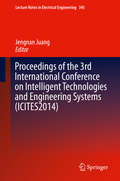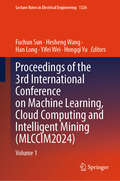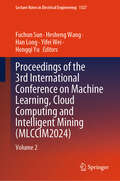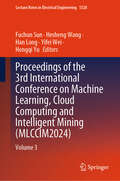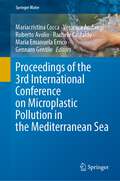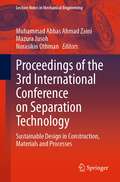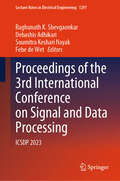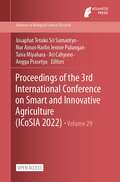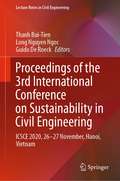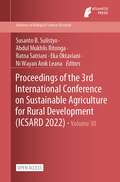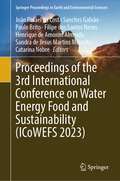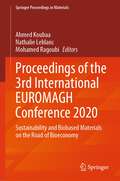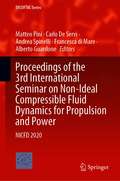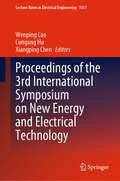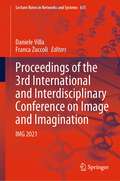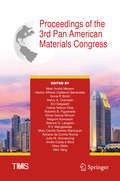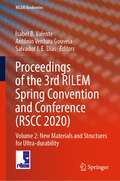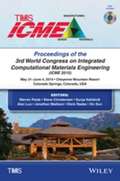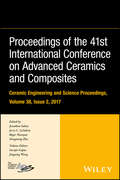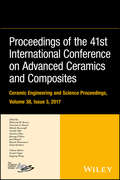- Table View
- List View
Proceedings of the 3rd International Conference on Intelligent Technologies and Engineering Systems (ICITES2014)
by Jengnan JuangThis book includes the original, peer reviewed research from the 3rd International Conference on Intelligent Technologies and Engineering Systems (ICITES2014), held in December, 2014 at Cheng Shiu University in Kaohsiung, Taiwan. Topics covered include: Automation and robotics, fiber optics and laser technologies, network and communication systems, micro and nano technologies and solar and power systems. This book also Explores emerging technologies and their application in a broad range of engineering disciplines Examines fiber optics and laser technologies Covers biomedical, electrical, industrial and mechanical systems Discusses multimedia systems and applications, computer vision and image & video signal processing
Proceedings of the 3rd International Conference on Machine Learning, Cloud Computing and Intelligent Mining: Volume 1 (Lecture Notes in Electrical Engineering #1326)
by Fuchun Sun Hesheng Wang Han Long Yifei Wei Hongqi YuThis proceedings book offers a meticulously curated compilation of peer-reviewed papers presented at the 3rd International Conference on Machine Learning, Cloud Computing and Intelligent Mining (MLCCIM2024). With a profound focus on these domains, this book serves as an invaluable resource for researchers, experts, professionals, and practitioners engaged in machine learning, control systems, robot, cloud computing, and intelligent mining techniques. The book facilitates a vibrant exchange of knowledge, enabling participants to unveil their pioneering research findings, showcase the outcomes of their latest projects, and engage in thought-provoking discussions to share perspectives and experiences.
Proceedings of the 3rd International Conference on Machine Learning, Cloud Computing and Intelligent Mining: Volume 2 (Lecture Notes in Electrical Engineering #1327)
by Fuchun Sun Hesheng Wang Han Long Yifei Wei Hongqi YuThe proceedings offer a meticulously curated compilation of peer-reviewed papers presented at the 3rd International Conference on Machine Learning, Cloud Computing and Intelligent Mining (MLCCIM2024). With a profound focus on these domains, this volume serves as an invaluable resource for researchers, experts, professionals, and practitioners engaged in machine learning, control systems, robot, cloud computing and intelligent mining techniques. The conference facilitated a vibrant exchange of knowledge, enabling participants to unveil their pioneering research findings, showcase the outcomes of their latest projects, and engage in thought-provoking discussions to share perspectives and experiences.
Proceedings of the 3rd International Conference on Machine Learning, Cloud Computing and Intelligent Mining: Volume 3 (Lecture Notes in Electrical Engineering #1328)
by Fuchun Sun Hesheng Wang Han Long Yifei Wei Hongqi YuThe proceedings offer a meticulously curated compilation of peer-reviewed papers presented at the 3rd International Conference on Machine Learning, Cloud Computing and Intelligent Mining (MLCCIM2024). With a profound focus on these domains, this volume serves as an invaluable resource for researchers, experts, professionals, and practitioners engaged in machine learning, control systems, robot, cloud computing and intelligent mining techniques. The conference facilitated a vibrant exchange of knowledge, enabling participants to unveil their pioneering research findings, showcase the outcomes of their latest projects, and engage in thought-provoking discussions to share perspectives and experiences.
Proceedings of the 3rd International Conference on Microplastic Pollution in the Mediterranean Sea (Springer Water)
by Mariacristina Cocca Maria Emanuela Errico Gennaro Gentile Veronica Ambrogi Roberto Avolio Rachele CastaldoMicroplastic pollution is a global problem, and its severity only threatens to get worse. This book presents all of the most up-to-date research on microplastic pollution, identifies issues and proposes actions to be taken and solutions to be implemented in facing down this environmental threat. The book details a host of aspects related to microplastic pollution, including: causes and effects; the impact on different environments; the emerging threat of nanoplastics; detection systems for monitoring areas subject to pollution; the ramifications in regard to other types of pollutants; green approaches for the synthesis of environmentally-friendly polymers; and socio-economic and environmental impact assessment and risk analysis, including in regard to effects on the human food chain. The primary audience for the book are scientists and decision-makers from industries, international, national and local institutions, and NGOs. It offers comprehensive information on the origin of the problem, its impact on marine environments, with particular attention to the Mediterranean Sea and Coasts, and the current research activities and ongoing projects aimed at finding technical solutions to mitigate the phenomenon.
Proceedings of the 3rd International Conference on Separation Technology: Sustainable Design in Construction, Materials and Processes (Lecture Notes in Mechanical Engineering)
by Muhammad Abbas Ahmad Zaini Mazura Jusoh Norasikin OthmanThis book contains papers presented in the 3rd International Conference on Separation Technology 2020 (ICoST 2020) held from 15 to 16th August 2020 at Johor, Malaysia. This proceeding contains papers presented by academics and industrial practitioners showcasing the latest advancements and findings in field of separation technology. The papers are categorized under the following tracks and topics of research:Environment EngineeringBiotechnologyAbsorption and Adsorption TechnologyWastewater TreatmentICoST 2020 covers multidisciplinary perspectives on separation research and aims to promote scientific information interchange between academics, researchers, graduates and industry professionals worldwide. This conference provides opportunities for the delegates to exchange new ideas and application experiences face to face, to establish business or research relations and to find global partners for future collaboration.
Proceedings of the 3rd International Conference on Signal and Data Processing: ICSDP 2023 (Lecture Notes in Electrical Engineering #1297)
by Debashis Adhikari Raghunath K. Shevgaonkar Soumitra Keshari Nayak Febe De WetThis volume comprises the select proceedings of the 3rd International Conference on Signal & Data Processing - ICSDP 2023. The contents focus on the latest research and developments in the field of artificial intelligence & machine learning, Internet of Things (IoT), cybernetics, advanced communication systems, VLSI embedded systems, power electronics and automation, MEMS/ nanotechnology, renewable energy, bioinformatics, data acquisition and mining, antenna & RF systems, power systems, biomedical engineering, aerospace & navigation. This volume will prove to be a valuable resource for those in academia and industry.
Proceedings of the 3rd International Conference on Smart and Innovative Agriculture (Advances in Biological Sciences Research #29)
by Josaphat Tetuko Sri Sumantyo Nur Ainun Harlin Jennie Pulungan Taira Miyahara Ari Cahyono Angga PrasetyaThis is an open access book.Held as part of the Universitas Gadjah Mada Annual Scientific Conferences (UASC 2022) series, the 3rd International Conference on Smart and Innovative Agriculture (ICoSIA 2022) provides an ideal academic platform for researchers to present the latest research findings and describe emerging technologies and directions in agriculture.This year, the conference will take the theme “Digital transformation, technology, and its solution for agriculture” with seven symposia: Agricultural Big Data Analysis symposium; Agricultural Geography symposium; Land and Environmental Management symposium; Precision Nutrition Technology symposium; Smart and Precision Farming symposium; Smart Genetics Resource Management and Utilization symposium; and Sustainable Food Production symposium.
Proceedings of the 3rd International Conference on Sustainability in Civil Engineering: ICSCE 2020, 26-27 November, Hanoi, Vietnam (Lecture Notes in Civil Engineering #145)
by Thanh Bui-Tien Long Nguyen Ngoc Guido De RoeckThis book contains the proceedings of the 3rd International Conference on Sustainability in Civil Engineering, ICSCE 2020, held on 26–27 November 2020, in Hanoi, Vietnam. It presents the expertise of scientists and engineers in academia and industry in the field of bridge and highway engineering, construction materials, environmental engineering, engineering in industry 4.0, geotechnical engineering, structural damage detection and health monitoring, structural engineering, geographic information system engineering, traffic, transportation and logistics engineering, water resources, estuary and coastal engineering.
Proceedings of the 3rd International Conference on Sustainable Agriculture for Rural Development (Advances in Biological Sciences Research #30)
by Susanto B. Sulistyo Abdul Mukhlis Ritonga Ratna Satriani Eka Oktaviani Ni Wayan Anik LeanaThis is an open access book.The 3rd International Conference on Sustainable Agriculture for Rural Development (ICSARD) 2022, which will be held on August 23, 2022 using zoom online platform. The 3rd ICSARD 2022 is organised by Faculty of Agriculture, Universitas Jenderal Soedirman.The topic, “Strengthening Sustainable Agriculture in the New Normal and Disruptive Technology Era”, including:Agrotechnology: Agroecology, Soil Science, Agronomy, Horticulture, Plant Protection, Plant Breeding and BiotechnologyFood Science and Technology: Food Processing Technology, Food Microbiology, Food Chemistry, Food Biochemistry, Agro-Industrial Management, Food and NutritionAgricultural and Biosystem Engineering: Farm Machinery, Precision Farming, Food Engineering, Instrumentation and Control in Biosystem Engineering, Bio-Environment Control and Management Engineering, Post-Harvest Handling and Processing Engineering, Renewable Energy, Agricultural Management and Information SystemSocio-Economics of Agriculture and AgribusinessOther topics related to sustainable agriculture
Proceedings of the 3rd International Conference on Water Energy Food and Sustainability (Springer Proceedings in Earth and Environmental Sciences)
by João Rafael da Costa Sanches Galvão Filipe dos Santos Neves Henrique de Amorim Almeida Sandra de Jesus Martins Mourato Paulo Brito Catarina NobreThis book presents some of the work presented at the 3rd International Conference on Water Energy Food and Sustainability—ICoWEFS 2023, with topics delving into critical global themes. Encompassing four pivotal domains—Water and Circular Economy, Energy, Agrifood, and Sustainability—this book covers cutting-edge research and innovative solutions. Within the ambit of Water and Circular Economy, the discussions span from the sustainable management of water resources, urban and industrial water consumption, to the challenges in governance and the impact of climate change. The Energy section covers chapters on energy production, urban and industrial systems, governance challenges, and the imperative transition toward circular economies. The Agrifood domain probes into sustainable agricultural practices, harnessing smart technologies in farming, climate change's effect on food production, and innovations in food processing. Lastly, the Sustainability segment encompasses a wide array of topics including bioeconomy sustainability, cyber-physical systems, climate change impacts, and resource efficiency, underpinning the urgent need for a holistic approach to global sustainability.
Proceedings of the 3rd International Congress of Applied Chemistry & Environment: Advances in Chemistry and Clean Processes on Materials and Nanomaterials (Springer Proceedings in Materials #23)
by Mohammad Jawaid Ramzi KhiariThis book presents the selected papers presented at the Third International Congress of Applied Chemistry & Environment (ICACE–3) that took place on May 27-29, 2022. The topics of the conference covers topics from the thematic sections: (1) Environment and Climate Change; (2) Green Chemistry and Natural Substances; (3) Biobased Materials and Nanomaterials; (4) Sustainable Textiles and Clean Processes. For this edition of the conference, it is devoted to present the advantage to use annual plants and/or lignocellulose material as sources for production of fibers and/or cellulose derivatives and/or nanocellulose material with focus on their processing, properties and applications. This book benefits lecturers, students, researchers and industrialists who are working in the field of natural fiber especially in order to preserve the forest resource and to satisfy the increasing demand in pulps.
Proceedings of the 3rd International EUROMAGH Conference 2020: Sustainability and Biobased Materials on the Road of Bioeconomy (Springer Proceedings in Materials #43)
by Ahmed Koubaa Nathalie Leblanc Mohamed RagoubiThis conference proceeding presents selected manuscripts from the EUROMAGH 2020 Conference entitled “Sustainability and Biobased Materials on the Road of Bioeconomy”. The content highlights technical progress and recent knowledge in the valorization of biomass into biobased materials, from extraction of natural polymers, biopolymers, to biobased mixtures from macro to nano scales. Topics include the following but not limited to: 1. Agroresources, fibers, nanofibers and nanoparticles reinforcements 2. Biocomposites and Nano biocomposites 3. Rheology, Bioprocess and Modeling 4. Plant aggregates, vegetal concrete and Industrial valorisation
Proceedings of the 3rd International Seminar on Non-Ideal Compressible Fluid Dynamics for Propulsion and Power: NICFD 2020 (ERCOFTAC Series #28)
by Francesca Di Mare Andrea Spinelli Matteo Pini Carlo De Servi Alberto GuardoneThis book contains a collection of the main contributions from the third edition of the NICFD conference, organized by the Special Interest Group on Non-Ideal Compressible Fluid Dynamics (SIG-49). It provides insight on the latest research findings in the field of NICFD that are relevant to a number of engineering applications related to the conversion of renewable and waste energy sources, like organic Rankine cycles, supercritical CO2 cycle power plants, combustors operating with supercritical fluids, and heat pumps. The various chapters of the book document research encompassing theoretical, computational, and experimental aspects of the gas dynamics of non-ideal reactive and non-reactive flows and their impact for the design of internal flow components (turbomachinery, heat exchangers, combustors). Since the accurate calculation of fluid thermo-physical properties is of great concern in NICFD, all the chapters address this problem by describing state-of-the-art models for the characterization of the properties of pure fluids and mixtures.
Proceedings of the 3rd International Symposium on New Energy and Electrical Technology (Lecture Notes in Electrical Engineering #1017)
by Xiangping Chen Cungang Hu Wenping CaoThe conference offers a forum for academic and technical communication for researchers and engineers working in the fields of energy science and technology, electrical systems, and power electronics. It conducts in-depth exchanges and discussions on pertinent subjects like new energy and electrical technology. The book aids scholars and engineers worldwide in understanding the academic development trend and expanding their lines of inquiry by disseminating the research status of cutting-edge technologies and scientific research accomplishments. It also strengthens international academic research, academic topics exchange, and discussion, and encourages the industrialization of academic achievements.
Proceedings of the 3rd International and Interdisciplinary Conference on Image and Imagination: IMG 2021 (Lecture Notes in Networks and Systems #631)
by Daniele Villa Franca ZuccoliThis book gathers peer-reviewed papers presented at the 3rd International and Interdisciplinary Conference on Image and Imagination (IMG), held in Milano, Italy, in November 2021. Highlighting interdisciplinary and multi-disciplinary research concerning graphics science and education, the papers address theoretical research as well as applications, including education, in several fields of science, technology and art. Mainly focusing on graphics for communication, visualization, description and storytelling, and for learning and thought construction, the book provides architects, engineers, computer scientists, and designers with the latest advances in the field, particularly in the context of science, arts and education.
Proceedings of the 3rd Malaysian International Tribology Conference (Lecture Notes in Mechanical Engineering)
by Syahrullail Samion Mimi Azlina Abu Bakar Shahira Liza Kamis Mohd Hafis Sulaiman Nurin Wahidah Mohd ZulkifliThis book is a compilation of selected papers presented at the 3rd Malaysian International Tribology Conference (MITC 2020) held in Langkawi, Malaysia, September 28–30, 2020. The book presents the advancement in the field of tribology and is divided into main topics such as bearing design, biotribology, dry friction and wear, green tribology, green lubricant, lubricant and fuel, surface engineering. The contents of this book appeal globally to scientists, scholars, engineers, and students from universities, research institutions, and industries working in the field of tribology.
Proceedings of the 3rd Pan American Materials Congress
by Terence G. Langdon Marc André Meyers Hector Alfredo Calderon Benavides Sonia P Brühl Henry A Colorado Elvi Dalgaard Carlos Nelson Elias Roberto B Figueiredo Omar Garcia-Rincon Megumi Kawasaki R. V. Mangalaraja Mery Cecilia Gomez Marroquin Adriana da Cunha Rocha Julie M Schoenung Andre Costa e Silva Mary Wells Wen YangThis collection covers a variety of materials science topics and has contributions from leading scientists and engineers representing 8 countries and 9 international materials, metals, and minerals societies. Papers are organized into the following sections: Advanced Biomaterials Advanced Manufacturing Materials for Green Energy Materials for Infrastructure Materials for the Oil and Gas Industry Materials for Transportation and Lightweighting Minerals Extraction and Processing Nanocrystalline and Ultra-fine Grain Materials and Bulk Metallic Glasses Steels
Proceedings of the 3rd RILEM Spring Convention and Conference: Volume 1: Strategies for a Resilient Built Environment (RILEM Bookseries #32)
by Eduardo B. Pereira Joaquim A. O. Barros Fabio P. FigueiredoThis book gathers peer-reviewed contributions presented at the 3rd RILEM Spring Convention and Conference, held at Guimarães and hosted by the University of Minho, Portugal, on March 9-14, 2020. The theme of the Conference was “Ambitioning a Sustainable Future for Built Environment: comprehensive strategies for unprecedented challenges”, which was aimed at discussing current challenges and impacts of the built environment on sustainability. The present volume is dedicated to the topic “Strategies for a resilient built environment”, which covers the current and emerging approaches that lead to an optimized design and maintenance of constructions and systems. It includes the development of service life models and life cycle design, in order to maximise longevity and level of service while minimising the environmental impact of constructions and systems. It also includes the analysis and design of larger systems, such as communities, cities or regions, aiming at reducing risk and increasing resilience. The following subtopics are included: resilience and robustness of the built environment and communities at local and global scales; risk based inspection and maintenance; life cycle analysis and service models; performance based design; improved design strategies by integrating materials and structures.
Proceedings of the 3rd RILEM Spring Convention and Conference: Volume 2: New Materials and Structures for Ultra-durability (RILEM Bookseries #33)
by Isabel B. Valente António Ventura Gouveia Salvador S. DiasThis book gathers peer-reviewed contributions presented at the 3rd RILEM Spring Convention and Conference, held at Guimarães and hosted by the University of Minho, Portugal, on March 9-14, 2020. The theme of the Conference was “Ambitioning a Sustainable Future for Built Environment: comprehensive strategies for unprecedented challenges”, which was aimed at discussing current challenges and impacts of the built environment on sustainability. The present volume is dedicated to the topic “New materials and structures for ultra‐durability”, which covers current scientific and technological developments aimed at improving knowledge about degradation mechanisms in construction materials, as well as to the development of new materials with extreme durability. Novel special materials for extreme environments or extreme loading conditions are also included, as well as novel approaches to improve the performance and durability of currently common construction materials. The following subtopics are included: general purpose, constructions, infrastructures and facilities; extreme environments and extreme events; transport and deterioration mechanisms, characterization and mitigation; Supplementary Cementitious Materials, admixtures, additions and other emerging material optimization strategies; smart materials for durable structures.
Proceedings of the 3rd RILEM Spring Convention and Conference: Volume 3: Service Life Extension of Existing Structures (RILEM Bookseries #34)
by José Sena-Cruz Miguel Azenha Luis CorreiaThis book gathers peer-reviewed contributions presented at the 3rd RILEM Spring Convention and Conference, held at Guimarães and hosted by the University of Minho, Portugal, on March 9-14, 2020. The theme of the Conference was “Ambitioning a Sustainable Future for Built Environment: comprehensive strategies for unprecedented challenges”, which was aimed at discussing current challenges and impacts of the built environment on sustainability. The present volume is dedicated to the topic “Service life extension of existing structures”, which covers the most recent scientific and technological developments in the understanding of the evolution and degradation of construction materials and structural systems. Analytical and numerical, as well as experimental approaches, aimed at characterizing, modelling and predicting the evolution of the physical, chemical and mechanical properties of construction materials and structural systems are regarded. Multiphysics models are also considered, as well as other strategies that contribute for an accurate characterization and prediction the service life and the evolution of existing and novel construction materials under normal or extreme environmental exposure or loading conditions. New strategies to promote the smart repairing or the recovery of material properties, as well as the service life extension, are also considered. The following subtopics are included: service life models and multiphysics approaches; smart structures, innovative monitoring and intervention strategies; management and optimized maintenance strategies; integrated rehabilitation and strengthening approaches.
Proceedings of the 3rd World Congress on Integrated Computational Materials Engineering (ICME)
by Dierk Raabe Warren Poole Xin Sun Surya Kalidindi Jonathan Madison Alan A. Luo Steve ChristensenThis book represents a collection of papers presented at the 3rd World Congress on Integrated Computational Materials Engineering (ICME), a specialty conference organized by The Minerals, Metals & Materials Society (TMS), and held in Colorado Springs, Colorado, May 31 - June 4, 2015. This meeting convened ICME stakeholders to examine topics relevant to the global advancement of ICME as an engineering discipline. The 42 papers presented in these proceedings are divided into six sections: (1) ICME Applications; (2) ICME Building Blocks; (3) ICME Success Stories and Applications (4) Integration of ICME Building Blocks: Multi-scale Modeling; (5) Modeling, Data and Infrastructure Tools, and (6) Process Optimization. The papers represent a cross section of the presentations and discussions from the conference. These papers are intended to further the global implementation of ICME, broaden the variety of applications to which ICME is applied, and ultimately help industry design and produce new materials more efficiently and effectively.
Proceedings of the 41st Industrial Waste Conference May 1986, Purdue University
by John M. BellThis 41st Edition presents case histories with operating data-and new research-on most topics of this major subject in today's world. This valuable Purdue Book will prove invaluable to all involved with waste treatment, providing information and data to help solve current problems. These proceedings of the May 1986 Purdue Conference include applications, research, methods and techniques, case histories, and operating data. The 91 papers include two special sections: 21 papers discuss toxic and hazardous wastes and 24 papers cover physical-biological systems. The book is further divided into papers on the following topics: (1) Pretreatment Programs and Systems; (2) Dairy Wastes; (3) Oilfield and Gas Pipeline Wastes; (4) Dye Wastes; (5) Coal, Coke and Power Plant Wastes; (6) Landfill Leachate; (7) Laws, Regulations, and Training; (8) Physical/Biological Systems; (9) Pulp and Paper Mill Wastes; (10) Plating Wastes; (11) Food Wastes; (12) Metal Wastes; and (13) Toxic and Hazardous Wastes.
Proceedings of the 41st International Conference on Advanced Ceramics and Composites (Ceramic Engineering and Science Proceedings #Vol. 38, Issue 2)
by Roger Narayan Jonathan Salem Jingyang Wang Dongming Zhu Jerry C. LaSalvia Surojit GuptaThis proceedings contains a collection of 23 papers from The American Ceramic Society’s 41st International Conference on Advanced Ceramics and Composites, held in Daytona Beach, Florida, January 22-27, 2017. This issue includes papers presented in the following symposia: Mechanical Behavior and Performance of Ceramics and Composites, Advanced Ceramic Coatings for Structural, Environmental, and Functional Applications, Armor Ceramics: Challenges and New Developments , Next Generation Bioceramics and Biocomposites , Global Young Investigators Forum
Proceedings of the 41st International Conference on Advanced Ceramics and Composites (Ceramic Engineering and Science Proceedings #Vol. 38, Issue 3)
by Tatsuki Ohji Narottam P. Bansal Soshu Kirihara Waltraud M. Kriven Jingyang Wang Yanchun Zhou Mihails Kusnezoff Josef Matyas Kyoung Il Moon Kiyoshi Shimamura Surojit GuptaThis proceedings contains a collection of 24 papers from The American Ceramic Society’s 41st International Conference on Advanced Ceramics and Composites, held in Daytona Beach, Florida, January 22-27, 2017. This issue includes papers presented in the following symposia: 14th International Symposium on Solid Oxide Fuel Cells (SOFC), 11th International Symposium on Advanced Processing & Manufacturing Technologies for Structural & Multifunctional Materials and Systems, Advanced Materials and Innovative Processing ideas for the Production Root Technology, Materials for Extreme Environments: Ultrahigh Temperature Ceramics (UHTCs) and Nano-laminated Ternary Carbides and Nitrides (MAX Phases), Advanced Materials for Sustainable Nuclear Fission and Fusion Energy, Crystalline Materials for Electrical, Optical and Medical Applications, Additive Manufacturing and 3D Printing Technologies, Focused Session 1 Geopolymers, Chemically Bonded Ceramics, Eco-friendly and Sustainable Materials
